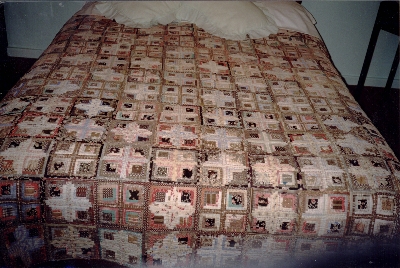Quilt No.571MM - Margaret McMillan

2200 x 2200mm
The quilt was made by Elizabeth Horrell (born Moore) (1827-1913). It was commenced by her in Devon England in 1837 when she was 11 years old. She married John Horrell in England in 1848 and they came to New Zealand on the 'Charlotte Jane' in 1850 with their eldest son Samuel. The quilt was completed in New Zealand around 1852-53.
"My grandmother- Margaret Horrell - told me the quilt was mine. Her husband William must have been given the quilt by Uncle Henry - who I recall stayed a lot with them and died in 1946. As a child I always slept under the quilt when I stayed in Ashburton N.Z. with my grandparents. Given to me at age 18. As I married and moved to Australia in 1962 my mother kept the quilt in N.Z. She decided to wash it and so in about 1970, I brought it back to Australia. It has been in use all its life." [Margaret McMillan 1.7.99]
Elizabeth Moore grew up at 'Moorefarm', Morchard Bishop, Devon England. The farm is still there and in tact.
" His wife (Elizabeth Horrell) had taught school in Devonshire and had a certificate from there and a testimonial from the Vicar. She took a class on the 'Charlotte Jane' which included Tom Phillips of The Point. After they settled in Christchurch she was assistant mistress under J.S.Hawley when St. Michael's school was started. It was said she taught in the school for three years and used to put her baby in a corner made comfortable with her sewing work."
[Part reference from 'Biographical Notes in Canterbury Museum' supplied by Margaret McMillan 1.7.99]
Related Quilts:
2420 x 1220
The patches are joined with hand sewing and embroidery, however the 12 panels are joined with machine stitching (chainstitch machine stitching). The blue silk lining was hand sewn into position with silk thread." [NGA]
"The quilt does consist of three layers but the central layer is not padding. The crazy patch pieces were sewn together and this was lined with white cotton fabric prior to the embroidery at the edges of the 12 panels being placed. This in turn was lined with a fine blue silk." [NGA] 1810 x 1460 mm
2390 x 2110mm
2000 x 2200mm
1580 x 1830mm
2439 x 1829mm






